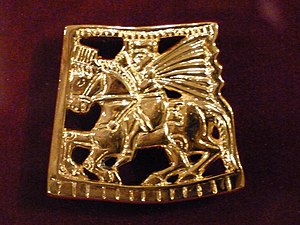
Back Usunlar Azerbaijani Вусуні Byelorussian Усуни Bulgarian Wu-sun Catalan Wusunové Czech Wusun German Wusun Spanish Wusun Basque ووسون Persian Wusun French

The Wusun (/ˈwuːsʌn/ WOO-sun)[a] were an ancient semi-nomadic steppe people mentioned in Chinese records from the 2nd century BC to the 5th century AD.
The Wusun originally lived between the Qilian Mountains and Dunhuang (Gansu) near the Yuezhi.[3] Around 176 BC the Xiongnu raided the lands of the Yuezhi, who subsequently attacked the Wusun, killing their king and seizing their land. The Xiongnu adopted the surviving Wusun prince and made him one of their generals and leader of the Wusun. Around 162 BC the Yuezhi were driven into the Ili River valley in Zhetysu, Dzungaria and Tian Shan, which had formerly been inhabited by the Saka. The Wusun then resettled in Gansu as vassals of the Xiongnu. In 133–132 BC, the Wusun drove the Yuezhi out of the Ili Valley and settled the area.
The Wusun then became close allies of the Han dynasty and remained a powerful force in the region for several centuries. The Wusun are last mentioned by the Chinese as having settled in the Pamir Mountains in the 5th century AD due to pressure from the Rouran. They possibly became subsumed into the later Hephthalites.
- ^ Cite error: The named reference
Zadneprovskiywas invoked but never defined (see the help page). - ^ Schuessler 2014, p. 264.
- ^ 《汉书·西域传》:乌孙国,大昆弥治赤谷城,去长安八千九百里。户十二万,口六十三万,胜兵十八万八千八百人。……故服匈奴,后盛大,取羁属,不肯往朝会。东与匈奴、西北与康居、西与大宛、南与城郭诸国相接。本塞地也,大月氏西破走塞王,塞王南越县度,大月氏居其地。后乌孙昆莫击破大月氏,大月氏徙、西臣大夏,而乌孙昆莫居之,故乌孙民有塞种、大月氏种云。
Cite error: There are <ref group=lower-alpha> tags or {{efn}} templates on this page, but the references will not show without a {{reflist|group=lower-alpha}} template or {{notelist}} template (see the help page).
